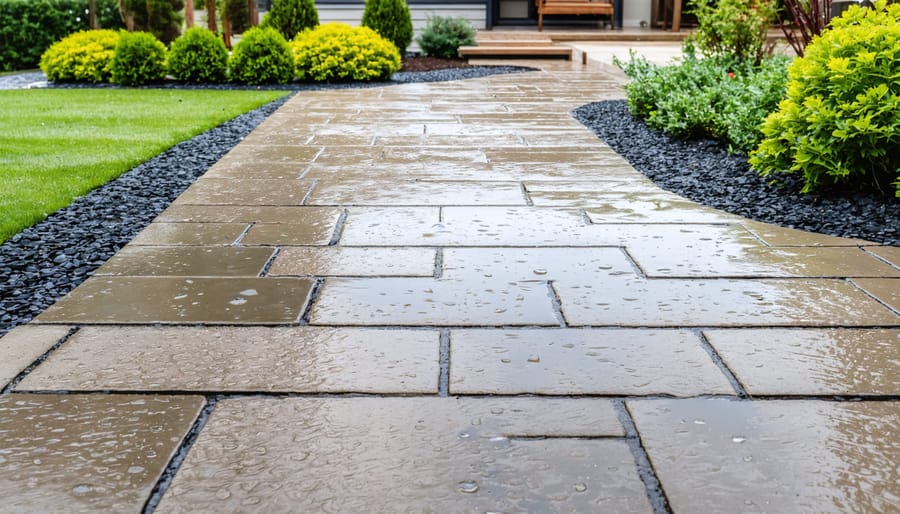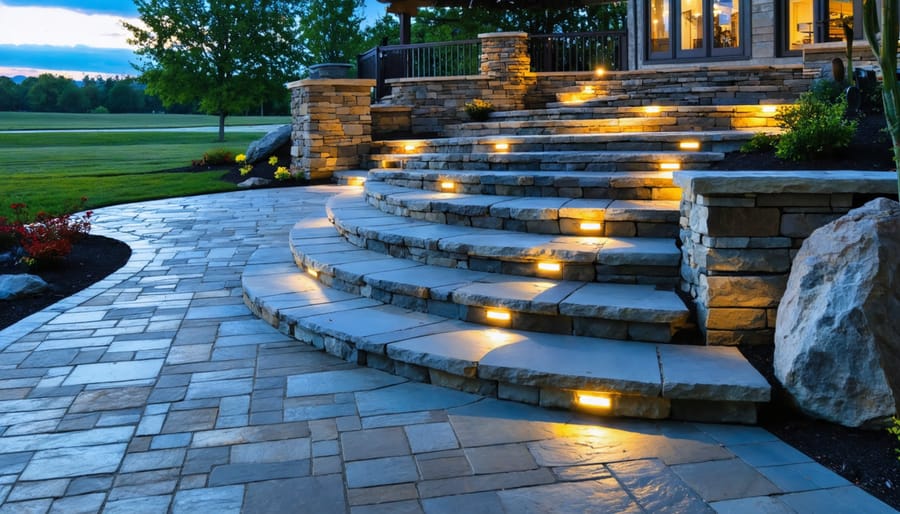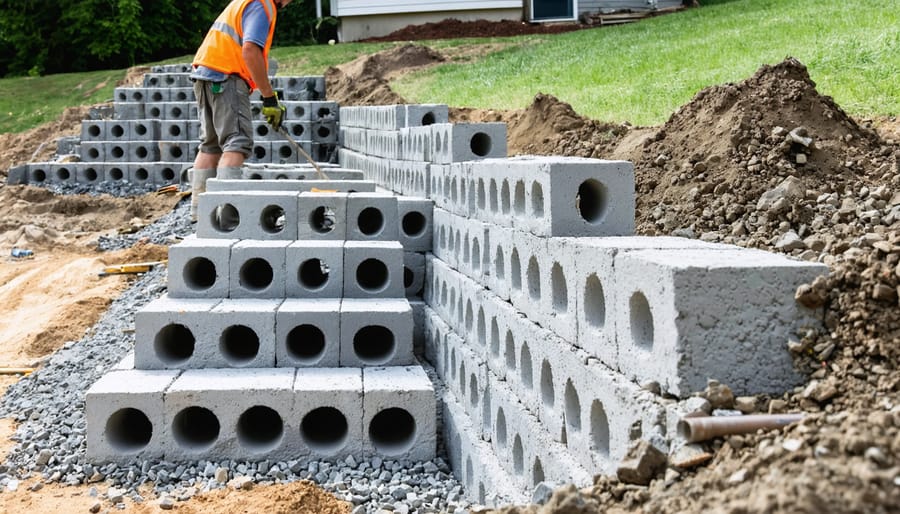Picture this: rainwater pooling on your patio, muddy pathways after every storm, or worse—water streaming toward your home’s foundation. If you’re battling garden drainage problems, permeable hardscaping offers an elegant solution that works with nature instead of against it.
Unlike traditional concrete or asphalt that sends every drop racing toward storm drains, permeable hardscaping allows water to filter naturally through surfaces into the soil below. This simple shift transforms problem areas into functional, beautiful spaces that actually improve your property’s water management.
Choose permeable pavers with gaps that fill with gravel or ground cover plants, allowing water to seep through while creating stunning walkways and patios. Install permeable gravel systems using stabilizing grids that prevent shifting while maintaining excellent drainage for driveways and parking areas. Consider porous concrete or asphalt that looks nearly identical to traditional surfaces but contains specially designed gaps that channel water through.
The benefits extend far beyond solving puddles. You’ll reduce runoff pollution, replenish groundwater naturally, prevent erosion, and create cooler outdoor spaces during summer heat. Many municipalities even offer incentives for installing permeable surfaces since they ease the burden on overtaxed stormwater systems.
Whether you’re planning a new patio, replacing an old driveway, or reimagining garden paths, permeable hardscaping delivers practical solutions that benefit your home, your garden, and your community. Let’s explore how these innovative materials can transform your outdoor spaces into both beautiful and environmentally responsible landscapes.
What Is Permeable Hardscaping? (And Why Your Garden Will Thank You)
Picture this: you’re standing in your driveway after a heavy rain, watching water cascade down toward the street in rivers, taking soil, mulch, and who knows what else with it. Meanwhile, your carefully planted garden beds are bone dry. Sound familiar? That’s the classic problem with traditional hardscaping—it’s essentially waterproof.
Traditional surfaces like concrete driveways, solid patios, and asphalt create what I like to call “water deserts.” Rain hits these impermeable surfaces and has nowhere to go but sideways, rushing off to storm drains instead of soaking into the ground where your plants desperately need it. It’s like putting a giant plastic tarp over half your yard!
Permeable hardscaping flips this script entirely. These clever systems—whether they’re porous pavers, gravel pathways, or specially designed permeable concrete—are built with intentional gaps or porous materials that let water filter through to the soil below. Think of them as hardscaping with a conscience.
Here’s why your garden will genuinely love you for making the switch: when rain falls on permeable surfaces, it slowly infiltrates the ground, replenishing moisture levels in nearby planting beds. Your trees, shrubs, and perennials get a steady drink instead of watching water rush past them. Plus, that gentle filtering action naturally removes pollutants before water reaches groundwater supplies.
Beyond keeping your plants happy, permeable hardscaping tackles erosion problems head-on. Without rushing water carving channels through your landscape, your soil stays put, your mulch doesn’t float away, and those delicate new plantings aren’t getting battered by runoff.
The beauty is that these systems work quietly in the background, managing water naturally while still giving you functional, attractive outdoor spaces. It’s sustainable gardening at its finest—helping nature do what it does best.

The Hidden Benefits Beyond Better Drainage
Healthier Soil and Plant Roots
One of the most overlooked benefits of permeable hardscaping is what’s happening beneath the surface. Unlike traditional concrete or asphalt that creates an impenetrable barrier, permeable materials allow essential oxygen and moisture to reach the soil below. This makes a world of difference for your garden’s foundation.
When soil can breathe, it stays loose and friable rather than becoming compacted and lifeless. I’ve seen gardens transform when homeowners switch from solid patios to permeable pavers—nearby plants suddenly thrive because their roots can finally spread and access the resources they need. Trees especially benefit, as their extensive root systems require oxygen exchange throughout the soil profile.
Permeable surfaces also support beneficial soil organisms like earthworms and microbes that are crucial for maintaining healthy soil structure. These tiny helpers need air and moisture to survive, and they reward you by naturally aerating the soil and breaking down organic matter into nutrients your plants can use.
This creates a living ecosystem beneath your pathways and patios rather than dead zones. Your entire landscape becomes more interconnected and resilient, with healthier plants that require less watering and fertilizing—a win for both your garden and your weekend plans!

Less Maintenance, More Time in the Garden
One of the most satisfying benefits of permeable hardscaping is how much time it gives you back. Instead of spending weekends repairing washouts or clearing clogged drainage systems, you’ll actually get to enjoy your garden.
Traditional impermeable surfaces create constant challenges. Heavy rains carve channels through mulched beds, pooling water kills plants, and you’re left scrambling with sandbags or digging new drainage trenches. It’s exhausting and takes away from the fun parts of gardening.
With permeable hardscaping, water simply disappears where it lands. No more erosion gullies cutting through your carefully planted borders. No more emergency repairs after every storm. The surface does the work for you, naturally managing rainfall without intervention.
I spoke with Lisa Martinez, a landscape designer with twenty years of experience, who told me: “My clients consistently report spending 70% less time on drainage maintenance after installing permeable systems. That’s hours they now spend planting, harvesting, or simply relaxing in their gardens.”
The reduced maintenance burden means you can focus on growing vegetables, cultivating flowers, or whatever brings you joy outdoors—not fighting water problems.
Environmental and Neighborhood Impact
Permeable hardscaping does wonderful things for your local environment that go far beyond your property line. When rain falls on traditional concrete or asphalt, it picks up motor oil, fertilizers, pesticides, and other pollutants before rushing into storm drains and eventually into nearby streams, rivers, and lakes. With permeable surfaces, rainwater filters naturally through layers of stone and sand that trap these contaminants before they reach groundwater supplies.
You’re also helping reduce the burden on municipal stormwater systems. During heavy rainfall, overwhelmed storm drains can cause flooding and even sewage backups in some communities. By allowing water to soak into the ground right where it falls, you’re keeping thousands of gallons out of those overloaded systems each year.
Perhaps most importantly, permeable hardscaping recharges local aquifers—the underground water supplies we all depend on. This becomes increasingly critical during drought conditions. When I spoke with landscape designer Maria Chen about her work with sustainable landscaping, she emphasized that “every permeable patio or driveway is like giving back to the earth’s natural water cycle.” Your choice to go permeable creates ripples of positive environmental impact throughout your entire neighborhood and watershed.
Popular Permeable Paving Options for Your Property
Permeable Pavers and Paving Stones
Permeable pavers are perhaps the most versatile option in your permeable hardscaping toolkit. These interlocking units—whether concrete, clay brick, or natural stone—are installed with intentional gaps between them that allow water to seep through to the soil below. I’ve used them in countless projects, and they never fail to impress with their dual personality: practical drainage solution meets stunning design element.
The beauty of permeable pavers lies in their adaptability. Those gaps between pavers can be filled with gravel, sand, or even low-growing plants like creeping thyme, adding visual interest while maintaining functionality. They’re perfect for patios where you want that classic brick look, walkways that need both charm and puddle-free performance, and even driveways that can handle vehicle weight without sacrificing permeability.
From rustic cobblestone to sleek modern rectangles, the aesthetic possibilities are endless. They work best on relatively flat terrain where proper base preparation ensures long-term stability. One landscape designer I interviewed swears by them for urban gardens, saying they “transform concrete jungles into rain-friendly havens.” Best of all, if a paver cracks or stains, you can simply replace individual pieces—no jackhammer required.
Porous Concrete and Asphalt
Porous concrete and asphalt offer the familiar look of traditional hardscaping with a water-friendly twist. These specially formulated materials feature tiny air pockets throughout their structure, allowing rainwater to filter straight through to the soil below rather than pooling on the surface.
The secret lies in reducing or eliminating fine particles in the mix, creating interconnected voids that water can navigate. Think of it like a sponge—those gaps make all the difference! While they’re incredibly effective at managing runoff, they do require some consideration. Porous surfaces can be vulnerable to clogging from dirt and debris, so regular vacuuming or power washing keeps them functioning properly.
These surfaces shine in driveways, patios, and walkways where you want a solid, uniform appearance but need better drainage. I’ve seen homeowners transform puddling driveways into well-draining spaces that never flood again. Just remember—they work best in areas without heavy sediment buildup and benefit from routine maintenance to keep those pores open and working.
Gravel and Crushed Stone
Gravel and crushed stone remain the most traditional and budget-friendly permeable hardscaping options available. I’ve used them countless times in my own garden, and they never disappoint for creating casual, natural-looking surfaces. These materials excel at allowing water to infiltrate while providing solid footing—plus, they’re wonderfully versatile.
The beauty of gravel lies in its simplicity and affordability. You can cover a substantial area without breaking the bank, making it perfect for garden paths, utility areas, and spaces where you want an informal aesthetic. The soft crunch underfoot adds sensory appeal that many gardeners love.
For best results, choose pea gravel for comfortable walking surfaces or larger crushed stone (¾-inch) for driveways and utility areas. Always install over landscape fabric with proper edging to prevent migration. While gravel requires occasional raking and replenishing, its low maintenance and excellent drainage make it ideal for areas where you prioritize function over formality. It’s particularly wonderful around sheds, compost bins, and cutting gardens where that relaxed, working-garden atmosphere feels just right.
Grass or Gravel Grid Systems
If you’re looking for a solution that combines strength with environmental benefits, grass or gravel grid systems might be your answer. These ingenious products use interlocking plastic or concrete grids to create a stable surface that can handle vehicle traffic while keeping water flowing naturally into the ground below.
Think of them as a supportive framework for your driveway or parking area. The grids have open cells that you fill with either soil and grass seed or gravel. The honeycomb structure distributes weight evenly, preventing ruts and compaction that would otherwise kill grass or scatter gravel. I’ve seen these transform muddy side yards into functional parking spaces that still look green and alive!
Grass-filled grids work beautifully for occasional-use driveways and overflow parking, giving you that lawn aesthetic while maintaining practicality. Gravel-filled versions suit higher-traffic areas and offer excellent drainage in spots where grass might struggle.
Installation is surprisingly straightforward—level your base, lay the grids, and fill the cells. Most homeowners can tackle this as a weekend project. The best part? You’re creating a permeable surface that reduces runoff while adding usable space to your property.

Planning Your Permeable Hardscaping Project
Assessing Your Soil and Drainage Needs
Before diving into your permeable hardscaping project, let’s figure out what you’re working with! Understanding your soil’s drainage characteristics will help you choose the right materials and design.
Start with a simple percolation test: dig a hole about 12 inches deep and wide, fill it with water, and let it drain completely. Fill it again and time how long it takes to empty. If water drains within 4-8 hours, you’ve got decent drainage. Slower than that? Your soil needs extra help managing water.
Walk your property after a good rain and note where puddles linger or where water rushes through. These problem spots are prime candidates for permeable solutions. Pay attention to areas near downspouts, sloped sections, and low-lying zones where water naturally collects.
The good news? Almost any property can benefit from permeable hardscaping, even if your soil isn’t perfect. Heavy clay soils might need additional gravel layers beneath your permeable surface, while sandy soils typically drain beautifully. Don’t let challenging conditions discourage you—they just mean you’ll need to adjust your approach slightly!
Choosing the Right System for Your Space
Selecting the perfect permeable system really comes down to understanding how you’ll use the space. For pedestrian areas like garden paths or patios where folks gather for evening barbecues, permeable pavers or gravel work beautifully and handle moderate rainfall with ease. But if you’re planning a driveway or parking area, you’ll need something sturdier—reinforced permeable pavers or porous concrete can support vehicle weight without cracking under pressure.
Climate plays a significant role too. In freeze-thaw regions, choose materials that won’t heave or crack during winter months. Permeable concrete performs exceptionally well in these conditions, while some plastic grid systems might become brittle in extreme cold.
Don’t forget aesthetics! Permeable options aren’t just functional—they’re gorgeous. Gravel comes in stunning colors, from warm honey tones to cool grays. Pavers offer endless design possibilities, letting you create patterns that complement your garden’s personality. I’ve seen homeowners transform ordinary driveways into artistic statements using multicolored permeable pavers.
Think about maintenance preferences too. Some systems require occasional sweeping to prevent clogging, while others need minimal attention beyond routine cleaning.
DIY or Professional Installation?
Simple projects like laying permeable pavers in small patios or creating gravel pathways are perfect DIY weekend adventures. If you’re handy with a shovel and can follow leveling instructions, you’ll save considerably on labor costs—often 40-50% of total expenses.
However, call in professionals for larger driveways, complex drainage issues, or when proper grading is critical. They’ll ensure the base layer is correctly installed (crucial for performance!) and handle permits if needed. I learned this the hard way when my first attempt at a permeable patio required do-overs because I skimped on base preparation.
Consider a hybrid approach: hire pros for site preparation and base work, then tackle the surface installation yourself. Many suppliers offer workshops on proper installation techniques, giving you confidence to succeed.
Caring for Your Permeable Surfaces
The beauty of permeable hardscaping is that it doesn’t demand complicated upkeep—just a bit of regular attention to keep everything flowing smoothly. Think of it as giving your pathways and patios the same care you’d give your garden beds, and you’ll find it fits naturally into your seasonal maintenance routine.
**Spring and Fall: Your Deep-Clean Seasons**
Twice a year, give your permeable surfaces a thorough cleaning to prevent debris from clogging those crucial gaps. A stiff-bristled broom works wonders for sweeping away accumulated leaves, dirt, and organic matter. For gravel or aggregate surfaces, use a leaf blower to clear out trapped material. If you notice stubborn blockages, a pressure washer (on a gentle setting) or a shop vacuum designed for wet/dry use can restore proper drainage. I make this task easier by tackling it the same day I clean my gutters—two drainage jobs in one afternoon!
**Summer: The Quick Check-In**
During growing season, keep an eye out for weeds poking through joints or between pavers. Pull them promptly before they establish deep roots. A quick sweep every few weeks prevents debris buildup and takes just minutes.
**Winter Preparation**
Before cold weather arrives, clear your permeable surfaces completely. Avoid using traditional salt-based de-icers, which can damage materials and reduce permeability. Instead, opt for sand or permeable-safe alternatives.
**Watch for Settling**
Once yearly, inspect for any areas where pavers have shifted or aggregate has compressed. Adding fresh joint material or releveling settled spots prevents drainage problems from developing. These small interventions keep your permeable hardscaping functioning beautifully for decades to come.

Making the switch to permeable hardscaping is more achievable than you might think. Whether you’re tackling a small patio or reimagining your entire driveway, you’re solving real problems—like stubborn puddles and runoff—while creating healthier conditions for everything you grow. Your garden will thank you with stronger root systems and better soil health. Remember, thoughtful hardscaping isn’t just about paths and patios; it’s about building a thriving ecosystem where water flows naturally and your plants flourish. You’ve got this!



